#1944 Cobra Woman
Explore tagged Tumblr posts
Text











Cobra Woman is a 1944 American South Seas adventure film from Universal Pictures, directed by Robert Siodmak that stars Maria Montez, Jon Hall, and Sabu. Shot in Technicolor, this film is typical of Montez's career at Universal, and, although mostly forgotten today by the general public, is venerated by film buffs as a camp classic for its legendary phallic snake-dance and Montez's words: "Geev me that Cobra jewl (sic)".
Avant-garde filmmaker Kenneth Anger has called it his favorite film. Film critic Leonard Maltin gave the film three stars out of four and called it a camp classic.
Plot (it may contain spoilers)
The beautiful Tollea is abducted and taken to Cobra Island, where she discovers that the Queen is her grandmother. Hava warns the angered Ramu not to go after Tollea, but he sets sail for the forbidden island, with his young friend Kado accompanying him as a stowaway.
A panther attacks Ramu, who is saved by a dart from Kado's deadly blowgun. They continue the search for Tollea, unaware that the high priestess of the island is Naja, her twin sister. The queen has ordered Tollea to be forcibly returned to Cobra Island only so she can displace her evil sister.
Ramu mistakenly becomes involved with Naja, who falls in love with him. Kado is captured and tortured by the brutal Martok, but refuses to reveal Ramu's whereabouts. Martok proceeds to murder the Queen.
When they finally meet, Naja attempts to kill her sister with a spear, but plunges to her own death instead. The evil Martok insists that Tollea perform a forbidden cobra dance, whereupon the island's volcano begins to violently erupt. It ceases when Martok is killed by Hava. When Ramu is about to return home, Tollea asks him to remain by her side and help her rule Cobra Island.
Cast
Maria Montez as Tollea/Naja
Jon Hall as Ramu
Sabu as Kado
Edgar Barrier as Martok
Mary Nash as the Queen
Lois Collier as Veeda
Samuel S. Hinds as Father Paul
Moroni Olsen as MacDonald
Lon Chaney Jr. as Hava (billed as Lon Chaney)
Production
Universal announced the film in June 1942 starring Montez, Hall, and Sabu, even before shooting had begun on their production of Arabian Nights. It was meant to follow that film but was pre-empted by White Savage.
Filming took place in May 1943.
Siodmak later called the film "silly but fun... Montez was a great personality and completely believed in her roles: if she was playing a princess you had to treat her like one all through lunch but if she was a slave girl you could kick her around anyhow and she wouldn't object: Method Acting before its time you might say."
It was first released the 19th April 1944.
Photos come from wikipedia, IMDB, Amazon, Iber Libro, Trailers from Hell & moviestore
Last photo has been shared by @74paris who recieved it from the Culture and Historical Heritage Service from Cabildo of La Palma. This very last photo was displayed at Maria's exibit celebrating her 100th birthday.
#Maria Montez#John Hall#Sabu#Cobra Woman#1944 Maria#1944 Cobra Woman#Robert Siodmak#La Reina del Tecnicolor#The Queen of Technicolor#Cabildo of La Palma#2012 Maria#collaboration
7 notes
·
View notes
Text

“Like [Mario] Lanza, Maria Montez had a reputation for being impossible to handle. After a number of years in Haji-Baba type adventures, she was dropped by Universal and forced to seek work in European cheapies. While in Europe, she attempted to counter her advanced state of avoirdupois with hot saline baths. She died in one of a heart attack at the age of thirty-one.”
/ From the book Flesh and Fantasy (1978) by Penny Stallings /
Died on this day in the Parisian suburb of Suresnes, France: golden age Hollywood’s nostril-flaring and tempestuous Queen of Technicolour Exotica, Caribbean Cyclone and leading lady of films like Arabian Nights (1942), White Savage (1943) and Cobra Woman (1944), Maria Montez (née María África Gracia Vidal, 6 June 1912 – 7 September 1951). Note: Stallings gets Montez’s age wrong in the quote above – she was 39 when she died. (Like any self-respecting diva, Montez had a “showbiz age”). Venerated by the likes of Gore Vidal and underground queer filmmakers Jack Smith, Andy Warhol and Kenneth Anger, Montez is a pivotal figure in the sensibility we now call “camp” and one of the original LGBTQIA icons. (Early Warhol drag superstar Mario Montez, for example, was christened after her). And aside from perhaps the young Yvonne De Carlo, did any woman wear a yashmak with more elan? “When I see myself on the screen, I look so beautiful I want to scream with joy” Montez once famously exclaimed. Maria Montez, you make ME scream with joy! Pictured: Montez in the 1949 film Siren of Atlantis playing – what else? – an evil queen.
#maria montez#exotica#siren of atlantis#lobotomy room#gay icon#old hollywood#classic hollywood#golden age hollywood#diva#kween#glamour#fierce#caribbean cyclone#queen of technicolor#kitsch#camp#retro#cobra woman
31 notes
·
View notes
Text
Coeli's Picks: Fantasy and Sci-Fi, part 2
(Multiple movies listed left to right.)
One Dress a Day Challenge
The Fall (2006) / Justine Waddell as Sister Evelyn


Cobra Woman (1944) / Maria Montez as Tollea/Naja
"Rather a contrast to the slinky green gown, eh?" (See third image.)
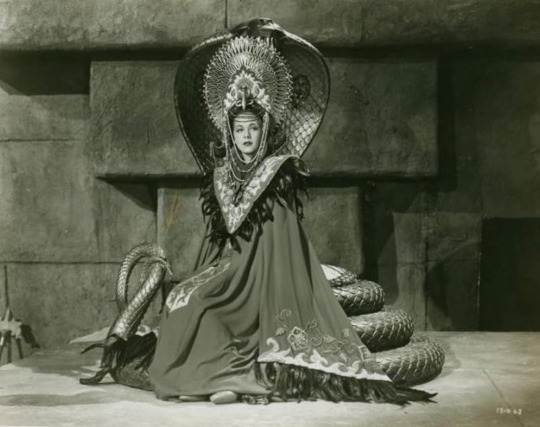


The Secret of Moonacre (2008) / Dakota Blue Richards as Maria Merryweather
Star Trek V: The Final Frontier (1989) / Cynthia Gouw as Caithlin Dar

Thor (2011) / Rene Russo as Frigga
"I adore the sculptural quality of the cloak."
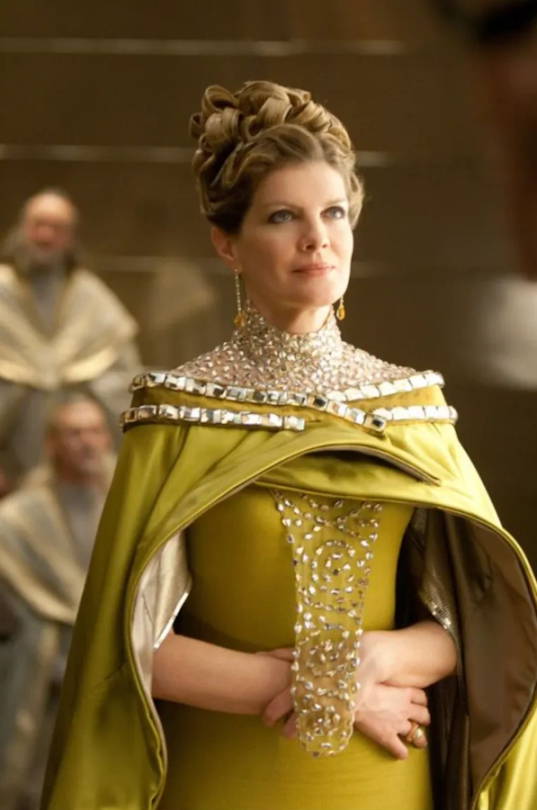
The Thief of Baghdad (1940) / June Duprez as the Princess

Return to Oz (1985) / Emma Ridley as Princess Ozma
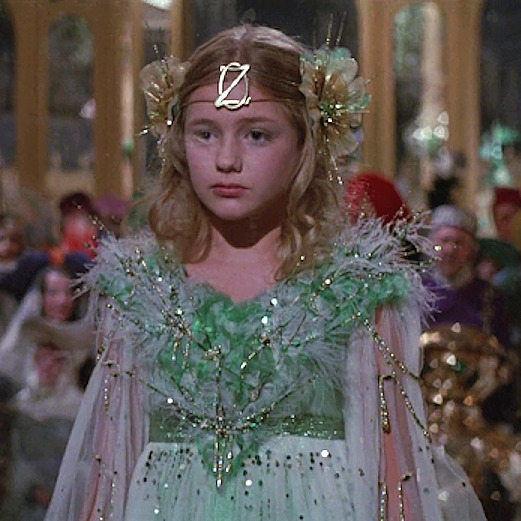
Forbidden Planet (1956) / Anne Francis as Altaira
One Million B.C. (1940) / Carole Landis as Loana
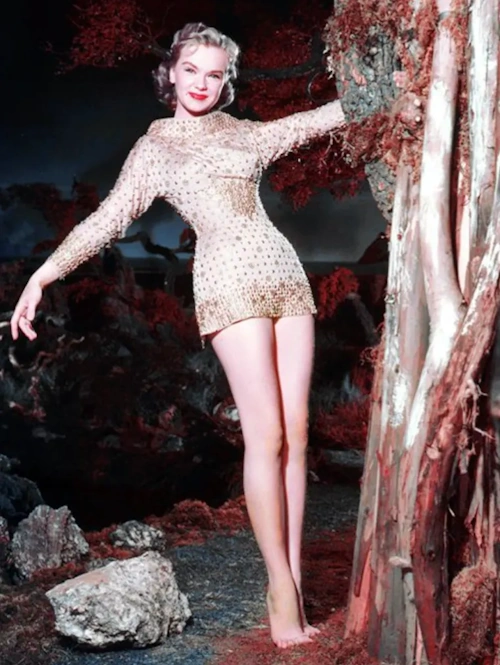

What a Way to Go! (1964) / Shirley MacLaine as Louisa May Foster
"This isn't, strictly speaking, fantasy or SF but it's certainly not realism!"
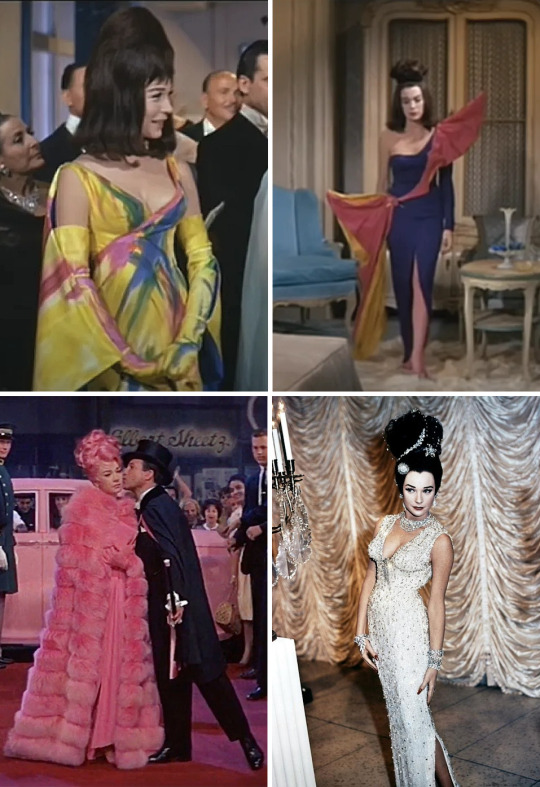
#coeli's picks#anything goes december#one dress a day challenge#one dress a week challenge#sci fi and fantasy#fantasy costumes#scifi costumes#the fall#mcu thor#marvel costumes#cobra woman#the thief of baghdad#the secret of moonacre#star trek v: the final frontier#return to oz#what a way to go#one million b.c.#forbidden planet#star trek movies#star trek
71 notes
·
View notes
Text
The promised Brazil in WW2 post! I did verify some information, but this is actually mostly based on my previous knowledge (from a Brazilian perspective) and my visit to a museum on this topic, so I always encourage searching about it yourself! :D This will be more general facts I find interesting than a complete look into our participation, as that is a bit complicated to speak about in a short post. But let's get into it, shall we?
So, the thing about Brazil's participation in WW2 is that it actually came in sort of late. We only started fighting in late 1944 in Northern Italy, after the fall of fascism there, but we technically declared war back in 1942.
The two reasons we entered the war (after a period of neutrality in which we still had a commercial relationship with the main three Axis countries as well as the Allies) were...
Getúlio Vargas' government striking a deal in which the USA would build military bases on our territory in exchange for them investing in our metallurgical industry (long story);
The German sinking of six commercial Brazilian ships (Baependi, Araraquara, Aníbal Benévolo, Itagiba, Arará and Jacira), which ended up killing 607 people, civilian and military alike.
Once we actually entered the war, I would say that our most important ally within the... Allies was the USA - with Brazilian soldiers (the Pracinhas) even serving in the US Fifth Army. We filled very important gaps, and eventually, once the USamericans turned their efforts elsewhere, we played a very important role in the fight against the Nazis in Italy.
A thing to note was actually the sense of connection that a lot of Brazilians had with Italy. Many of the soldiers drafted (and those who volunteered) were of European descent, with a sizable chunk being Italian, so they were both fighting for their homeland and for their ancestors' homeland. Not only that, but the Pracinhas were treated warmly by the Italian citizens, which nurtured an even stronger emotional bond and sense of duty.
The main battle fought by FEB (The Brazilian Expeditionary Forces) was the Battle of Monte Castelo - was a very important defense point for the Nazis - which lasted for three months and was considered the largest battle in the history of the Brazilian Army. Brazil also participated in the Battle of Castelnuovo, Montese, Collecchio, and Fornovo di Taro.

A big thing to mention is that there were actually Brazilians on both sides of the war. Which actually contributed to the psychological warfare by the Nazis to try and convince the Pracinhas to desert - there was even a radio program transmited by a Brazilian woman from Santa Catarina to try and reach that goal, although most of the propaganda was done through leaflets that would appeal to the conditions the soldiers were enduring (such as the extreme cold).
Interesting tidbit about the cold: the Pracinhas would stuff straw in their boots, especially when it was cold, which actually led them to have fewer cases of Trench Foot than the USamericans.
Women in the Brazilian Army acted as field nurses, about 73 iirc going to serve in Italy. I will attach a picture below of some of them.

At this time, Brazil was actually in a dictatorship, which restricted even what the Brazilians could write in letters back home. They were encouraged to never say anything negative, and even if they did, their letters would always be read to check for it. Interestingly enough, once the war was ending and the Pracinhas would come home, people began seeing more and more similarities between the way things were being run by the Vargas' regime and the nazifascists... Hm...
Let's get to the last thing I want to talk about this night - the symbols used by our soldiers!
The main one you may have seen around is the Smoking Cobra. But what does it mean? See, there was this popular phrase within the country that "if Brazil enters the war, the cobra will smoke", something akin to "when pigs fly". And so, when we did join the war, this symbol was used as a sort of cheeky nod to the saying. The Pracinhas had a really good sense of humor.
And the less known, but in my opinion just as funny, symbol for our Aviation group. Which was based on two things: the phrase "Senta a Pua" which was already used in the airbase of Salvador to tell people to hurry up, and the ostrich, a symbol based on soldiers' jokes that they needed an ostrich's stomach to handle the food the USamericans gave them on the boat ride over lmao. I put both symbols below.
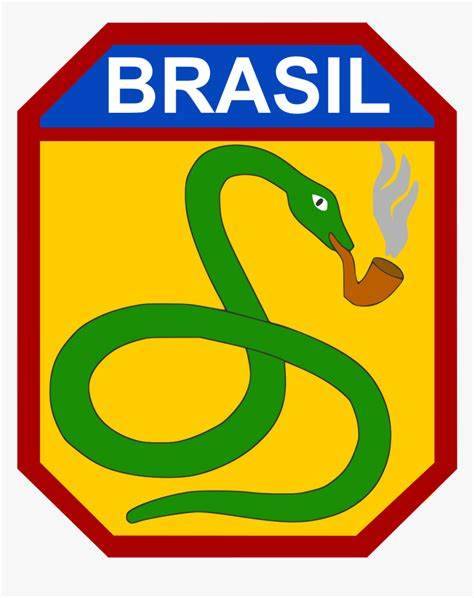

And I believe that will be all for now! There's still a lot to be said, and a lot that I will want to talk about at some point, but for now, I hope you enjoyed this little snapshot I gave you. ^_^
#geisttalk#two long posts in a single day who could've thunk it#plus some museum photos :)#ok now I will go sleep gn
11 notes
·
View notes
Text

Maria Montez in Cobra Woman (1944)
93 notes
·
View notes
Text

María Montez-Jon Hall "La reina de Cobra" (Cobra woman) 1944, de Robert Siodmak.
2 notes
·
View notes
Text

This promo image of Dominican actress Maria Montez in costume for her starring role in 1944's The Cobra Woman sells the movie for us.
1 note
·
View note
Photo
“After her adoring audience had grown up, they discovered that María África Vidal de Santo hadn’t done her own singing (she was dubbed), nor her own dancing; her ability as an actress was also put into question, but her spell was not tarnished. Maria Montez was still the madly glamorous South American Queen of Technicolour. What her roles (all of them variations of Scheherazade in slumberland) required were ingredients she had a surplus of: statuesque bearing, regal demeanour, fiery beauty and best of all an unassailable confidence in herself. When one weighed all the things she couldn’t do against the things she did so well, the balance came out in her favour.”
/ From John Kobal’s Hollywood Colour Portraits (1981) /
Born on this day: golden age Hollywood’s tempestuous high empress of kitsch exotica, nostril-flaring Dominican actress and “Caribbean Cyclone” Maria Montez (née María África Gracia Vidal, 6 June 1912 - 7 September 1951). Venerated by the likes of Gore Vidal and underground queer filmmakers Jack Smith, Andy Warhol and Kenneth Anger, the leading lady of films like Arabian Nights (1942), White Savage (1943) and Cobra Woman (1944) (pictured) is a pivotal figure in the sensibility we now call “camp” and one of the original LGBTQIA icons. (Early Warhol drag superstar Mario Montez, for example, was christened after her). And aside from perhaps the young Yvonne De Carlo, did any woman wear a yashmak with more elan? “When I see myself on the screen, I look so beautiful I want to scream with joy” Montez once famously exclaimed. Maria Montez, you make ME scream with joy!
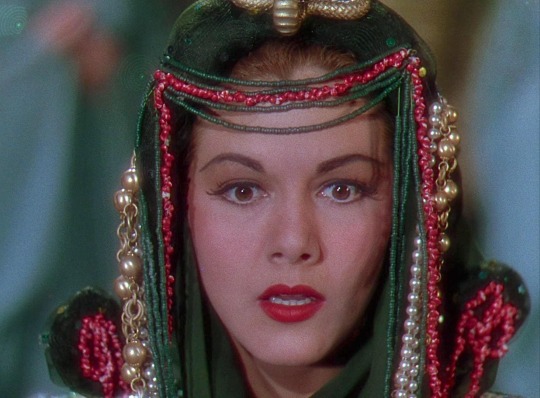
Cobra Woman https://tinyurl.com/2bg4g8qn She couldn’t act, couldn’t sing and danced like a wardrobe but for a while Maria Montez was quite the thing. Cobra Woman is probably the best example of a string of successful movies she made in the 1940s, often with the likeable, four-squ…
#maria montez#cobra woman#exotica#kitsch#caribbean cyclone#queen of technicolor#lobotomy room#camp#retro#gay icon#pride month#pride month 2024#queer#old hollywood#classic hollywood#golden age hollywood#gore vidal#kenneth anger#jack smith#mario montez#andy warhol#bad movies we love
6 notes
·
View notes
Text

Born 100 years ago today: Indian actor Sabu (Sabu Dastagir, 27 January 1924 – 2 December 1963). The doe-eyed and beauteous Sabu is particularly notable for being perhaps the sole Asian and Muslim major celebrity of Golden Age Hollywood. As with Chinese American star Anna May Wong in the twenties and thirties, the prejudiced dictates of the era limited the types of roles Sabu could play (in the Production Code there could be no hint of interracial romances depicted onscreen, for example) and he continued to portray “primitive” child-of-the-Islands stereotypes well into his thirties. (This is not meant as a diss on Sabu – he performed these parts with genuine aplomb and innate dignity). His most celebrated films include The Thief of Bagdad (1940), The Jungle Book (1942) and Black Narcissus (1947) but perversely, my favourite is camp classic Cobra Woman (1944) starring "the Caribbean Cyclone" Maria Montez – perhaps because Sabu cavorts in little more than a loincloth throughout. Sadly, Sabu died aged just 39 of heart disease.
#sabu#indian actor#classic hollywood#golden age hollywood#old hollywood#lobotomy room#exotica#the thief of bagdad#cobra woman#black narcissus#the jungle book
34 notes
·
View notes
Text
Coeli's picks: Green, part 2
Multiple movies listed left to right.
One Dress a Day Challenge
July: Green Redux (+ Blue Redux)
My Fair Lady (1964) / Audrey Hepburn as Eliza Doolittle

Oklahoma! (1955) / Gloria Grahame as Ado Annie
The Muppet Show / Gladys Knight as Herself
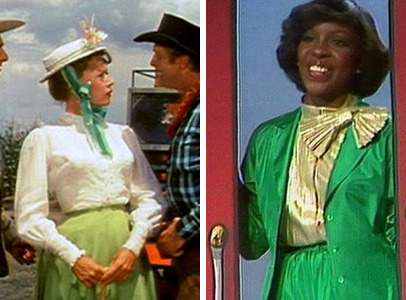
Riverdale / Madelaine Petsch as Cheryl Blossom
"On Riverdale, the character Cheryl Blossom wears a lot of green (goes well with her vivid red hair). This is my favorite."
Heathers (1988) / Shannon Doherty as Heather Duke
"In Heathers, the Heathers are color-coded. Heather Duke wears green. This is perhaps her most iconic outfit."

Anne Boleyn / as Anne Boleyn
"A recent miniseries about Anne Boleyn had a really striking green dress (and race-blind casting)."
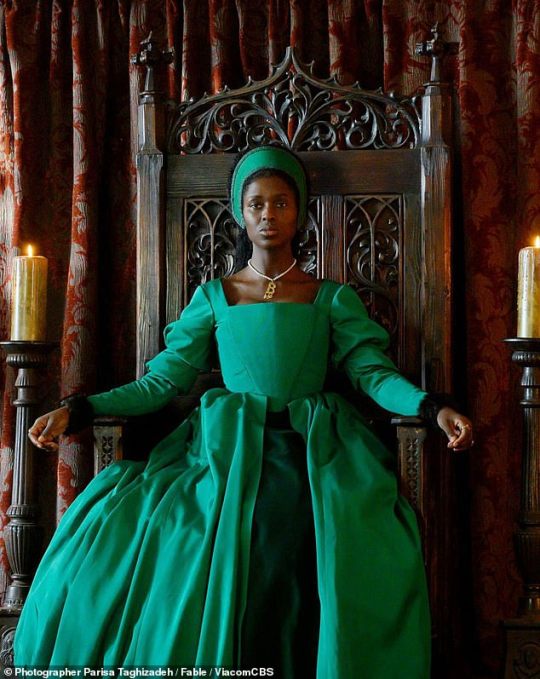
Allied (2016) / Marion Cotillard as Marianne Beauséjour

Frida (2002) / Salma Hayek as Frida Kahlo
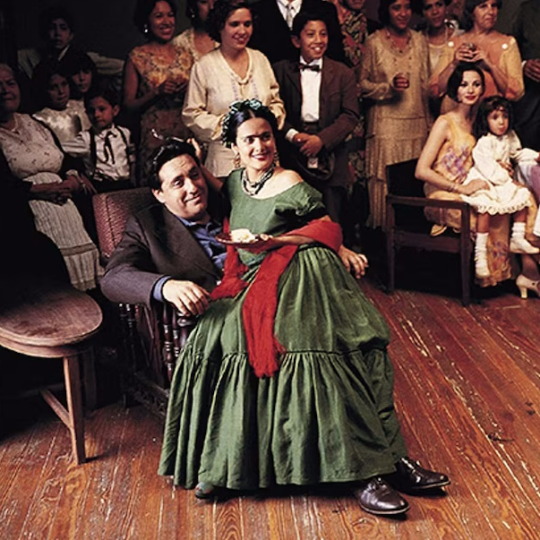
Vanity Fair (20014) / Reese Witherspoon as Becky Sharp
(I featured a different costume from this movie, here. Note the "red ribbon of hope" on the coat!)

Memoirs of a Geisha (2005) / Michelle Yeoh as Mameha
Tut (2015) / Sibylla Deen as Ankhesenamun
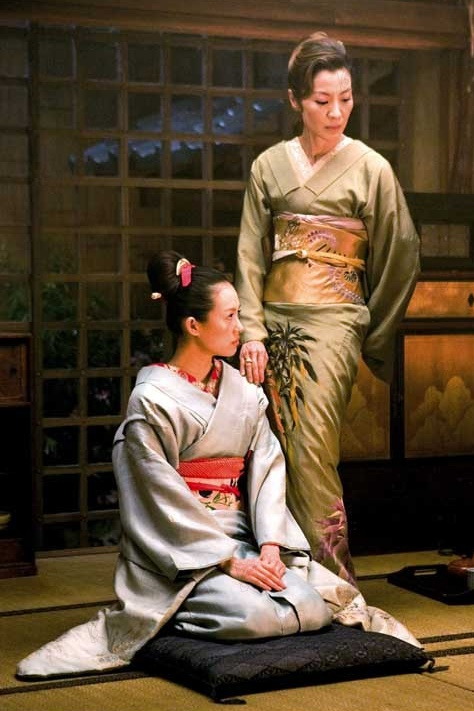
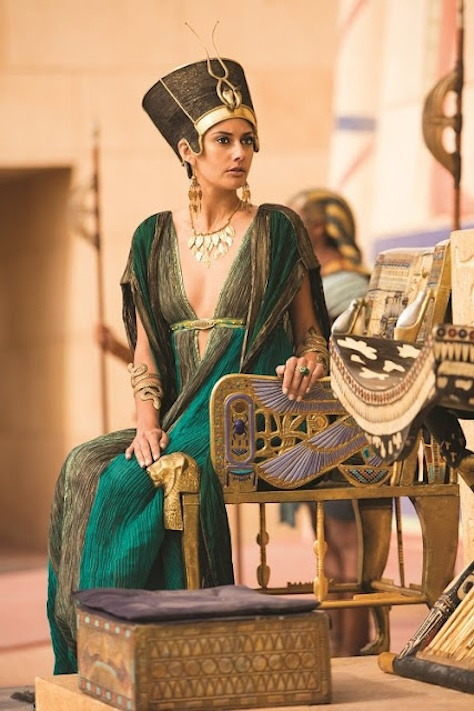
Cobra Woman (1944) / Maria Montez as Naja
"This might only appear in the poster. It's worth looking at some of the other costumes though - quite dramatic!"
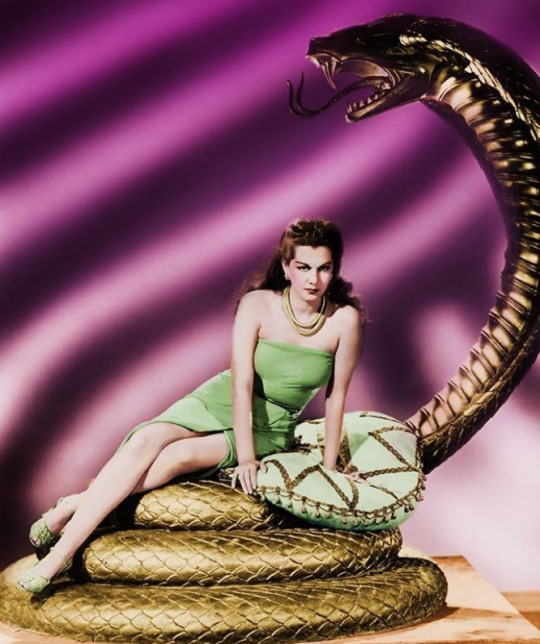
#coeli's picks#green dresses#movie costumes#one dress a day challenge#one dress a week challenge#television costumes#tv costumes#my fair lady#cobra woman#vanity fair 2004#tut#frida#memoirs of a geisha#riverdale#heathers#oklahoma#the muppet show#anne boleyn#allied#allied movie#green dress#green redux
11 notes
·
View notes
Text
Maria Montez decides who's going to die. COBRA WOMAN, 1944




40 notes
·
View notes
Text
The one and only, Tina's mum!!!

Maria Montez in "Cobra Woman", 1944 - via x
#Maria Montez#Cobra Woman#1944 Maria#1944 Cobra Woman#1944 Maria Montez#La Reina del Tecnicolor#The Queen of Technicolor#classic Hollywood#Old hollywood
334 notes
·
View notes
Photo

Maria Montez in: Cobra Woman (Dir. Robert Siodmak, 1944). Source
517 notes
·
View notes


